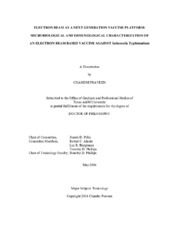| dc.description.abstract | Vaccines against infectious diseases are a corner stone of public health globally.
Vaccine technology based on attenuation, conventionally “killed” or cellular sub-units
suffer from significant drawbacks. Live attenuated vaccines impart strong cellular and
humoral immune response compared to inactivated or subunit vaccines, but there is an
increased risk of infection from the potential virulence reversion in such formulations.
The current study explores the use of eBeam irradiation as a novel tool for vaccine
generation. The value of eBeam based vaccines is that, they combine the safety of
“killed” vaccines, yet retain the immunogenicity of “attenuated” vaccines. The principle
of eBeam vaccine is eBeam irradiation will only irreversibly damage the target
microorganism’s nucleic acid without modifying the antigenic properties of surface
macromolecules. In this study microbiological characterization of eBeam based S.
Typhimurium (EBST) vaccine was carried out. The immunological correlates of
protection induced by the EBST in dendritic cell (DC) (in vitro) and mice (in vivo)
model were also assessed.
Results showed that eBeam inactivation preserved the potent proinflammatory
and immunogenic properties of S. Typhimurium. The EBST remained metabolically
active yet unable to multiply under favorable in vitro and in vivo conditions. The EBST
potently stimulated innate pro inflammatory response (TNFα) and maturation (MHC-II,
CD40, CD80 and CD86) of DC. Immunostimulatory potential of EBST was on par with
live Salmonella, and most importantly on par with a commercial Salmonella vaccine. Results from the mice challenge studies demonstrated the involvement of CD4+T cells as
key player in cell mediated immune response of EBST immunized mice, triggering the
production of Th1 cytokine IFNγ. This indicates the stimulation and development of
robust Salmonella specific T cell response similar to that caused by the live attenuated
vaccine (AroA- ST) formulation. The colonization of virulent Salmonella was also
reduced in EBST immunized mice similar to AroA immuninized mice. The EBST
retained stable immunogenic properties for several months at room temperature, 4°C, -
20°C and also after lyophilization. These findings highlight the potential of eBeam
technology as an effective and affordable next generation vaccine platform to address
global public health issues. | en |


